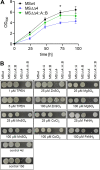Identification and Characterization of Mycobacterium smegmatis and Mycobacterium avium subsp. paratuberculosis Zinc Transporters
- PMID: 33722846
- PMCID: PMC8117522
- DOI: 10.1128/JB.00049-21
Identification and Characterization of Mycobacterium smegmatis and Mycobacterium avium subsp. paratuberculosis Zinc Transporters
Abstract
Zinc uptake in bacteria is essential to maintain cellular homeostasis and survival. ZnuABC is an important zinc importer of numerous bacterial genera, which is expressed to restore zinc homeostasis when the cytosolic concentration decreases beyond a critical threshold. Upon zinc limitation the fast-growing nonpathogenic organism Mycobacterium smegmatis (MSMEG) as well as the ruminant pathogen M. avium subsp. paratuberculosis (MAP) increases expression of genes encoding ZnuABC homologues, but also of genes encoding other transporters. This suggests an involvement of these transporters in zinc homeostasis. Here we characterized the putative zinc transporters of MSMEG (ZnuABC and ZnuABC2) and MAP (ZnuABC, MptABC, and MAP3774-76). Deletion of either ZnuABC or ZnuABC2 in MSMEG did not lead to growth defects, but to an increased expression of zinc marker genes in MSMEGΔznuABC, indicating cytosolic zinc limitation. However, chromatin immunoprecipitation proved direct binding of the global zinc regulator Zur to promoter regions of both znuABC and znuABC2. Simultaneous deletion of both transporters caused severe growth defects, which could be restored either by homologous complementation with single ZnuABC transporters or supplementation of growth media with zinc but not iron, manganese, cobalt, or magnesium. Heterologous complementation of the double mutant with MAP transporters also resulted in reconstitution of growth. Nonradioactive FluoZinTM-3AM zinc uptake assays directly revealed the competence of all transporters to import zinc. Finally, structural and phylogenetic analyses provided evidence of a novel class of ZnuABC transporters represented by the ZnuABC2 of MSMEG, which is present only in actinobacteria, mainly in the genera Nocardia, Streptomyces and fast growing Mycobacteria IMPORTANCEZinc is necessary for bacterial growth but simultaneously toxic when in excess. Hence, bacterial cells have developed systems to alter intracellular concentration. Regulation of these systems is primarily executed at transcriptional level by regulator proteins which sense femtomolar changes in the zinc level. In environmental and pathogenic mycobacteria zinc starvation induces expression of common zinc import systems such as the ZnuABC transporter, but also of other additional not yet characterized transport systems. In this study, we characterized the role of such systems in zinc transport. We showed that transport systems of both species whose transcription is induced upon zinc starvation can exchangeably restore cellular zinc homeostasis in transporter deficient mutants by transporting zinc into the cell.
Copyright © 2021 American Society for Microbiology.
Figures







Similar articles
-
Critical Role of Zur and SmtB in Zinc Homeostasis of Mycobacterium smegmatis.mSystems. 2020 Apr 21;5(2):e00880-19. doi: 10.1128/mSystems.00880-19. mSystems. 2020. PMID: 32317393 Free PMC article.
-
Identification of a lineage specific zinc responsive genomic island in Mycobacterium avium ssp. paratuberculosis.BMC Genomics. 2014 Dec 6;15(1):1076. doi: 10.1186/1471-2164-15-1076. BMC Genomics. 2014. PMID: 25481572 Free PMC article.
-
The transcriptional regulator Zur regulates the expression of ZnuABC and T6SS4 in response to stresses in Yersinia pseudotuberculosis.Microbiol Res. 2021 Aug;249:126787. doi: 10.1016/j.micres.2021.126787. Epub 2021 May 10. Microbiol Res. 2021. PMID: 33991717
-
Zinc homeostasis in Pseudomonas.Biometals. 2023 Aug;36(4):729-744. doi: 10.1007/s10534-022-00475-5. Epub 2022 Dec 6. Biometals. 2023. PMID: 36472780 Free PMC article. Review.
-
Competition for zinc binding in the host-pathogen interaction.Front Cell Infect Microbiol. 2013 Dec 24;3:108. doi: 10.3389/fcimb.2013.00108. eCollection 2013. Front Cell Infect Microbiol. 2013. PMID: 24400228 Free PMC article. Review.
Cited by
-
ZrgA contributes to zinc acquisition in Vibrio parahaemolyticus.Virulence. 2023 Dec;14(1):2156196. doi: 10.1080/21505594.2022.2156196. Virulence. 2023. PMID: 36482737 Free PMC article.
-
Identification and characterization of zinc importers in Corynebacterium diphtheriae.J Bacteriol. 2024 Jun 20;206(6):e0012424. doi: 10.1128/jb.00124-24. Epub 2024 May 29. J Bacteriol. 2024. PMID: 38809016 Free PMC article.
References
-
- Mertens J, Smolders E. 2013. Zinc, p 465–493. In Alloway BJ (ed), Heavy metals in soils: trace metals and metalloids in soils and their bioavailability, 3rd ed, vol 22. Springer, Dordrecht, The Netherlands.
LinkOut - more resources
Full Text Sources
Other Literature Sources

